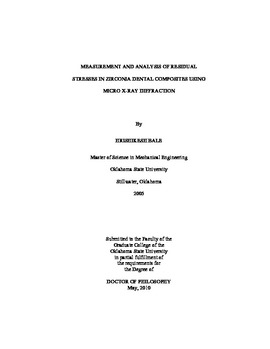| dc.contributor.advisor | Hanan, Jay C. | |
| dc.contributor.author | Bale, Hrishikesh A. | |
| dc.date.accessioned | 2013-12-10T18:05:12Z | |
| dc.date.available | 2013-12-10T18:05:12Z | |
| dc.date.issued | 2010-05 | |
| dc.identifier.uri | https://hdl.handle.net/11244/7786 | |
| dc.description.abstract | Due to their aesthetic value and high compressive strength, dentists are utilizing ceramics as a material of choice for dental restorations. Among ceramics, zirconia provides high toughness and crack resistance. Residual stresses develop in processing due to factors including coefficient of thermal expansion mismatch, geometry, and grain anisotropy. In the present study, advanced methods were adapted including polychromatic X-ray (Laue) micro-diffraction, which provided grain orientation and residual stresses, and monochromatic diffraction in the sin-squared-psi mode. Analysis tools for both methods were developed to provide grain averaged and grain specific material properties on clinically relevant specimens. | |
| dc.description.abstract | Large type II residual stress variations ranging from - 1 to + 1 GPa were observed between grains. Most grains in monolithic zirconia have a mean compressive deviatoric stress of 70 MPa, depending on direction. Another important part of the study was the interface residual stresses which occur at the interface of a base/core region of a dental restoration and the veneer. Type I residual stresses as high as 800 MPa were observed at the interface. A detailed analysis of the effects of simulated mouth motion impact fatigue cycling on the residual stress states revealed significant relaxation of the residual stress from 800 MPa to around 150 MPa within 45,000 cycles. Results from the sin-squared-psi; residual stress measurement technique revealed significantly higher tensile stresses in the zirconia core. Equivalent to approximately one year's service, 45,000 fatigue cycles at a load of 150N led to fracture of the porcelain veneer cusp. Residual stress at the site of fracture indicates relaxation of residual stress. At the interface, stress induced phase transformation of zirconia forming monoclinic phase was observed. Residual stresses can promote crack growth and thereby catastrophic failure. These results have implications for all materials particularly structural ceramics. | |
| dc.format | application/pdf | |
| dc.language | en_US | |
| dc.rights | Copyright is held by the author who has granted the Oklahoma State University Library the non-exclusive right to share this material in its institutional repository. Contact Digital Library Services at lib-dls@okstate.edu or 405-744-9161 for the permission policy on the use, reproduction or distribution of this material. | |
| dc.title | Measurement and analysis of residual stresses in zirconia dental composites using micro X-ray diffraction | |
| dc.contributor.committeeMember | Singh, Raman Pal | |
| dc.contributor.committeeMember | Kalkan, A. Kaan | |
| dc.contributor.committeeMember | Rubenstein, David A. | |
| dc.contributor.committeeMember | Smay, James Earl | |
| osu.filename | Bale_okstate_0664D_10757.pdf | |
| osu.accesstype | Open Access | |
| dc.type.genre | Dissertation | |
| dc.type.material | Text | |
| thesis.degree.discipline | Mechanical and Aerospace Engineering | |
| thesis.degree.grantor | Oklahoma State University | |
